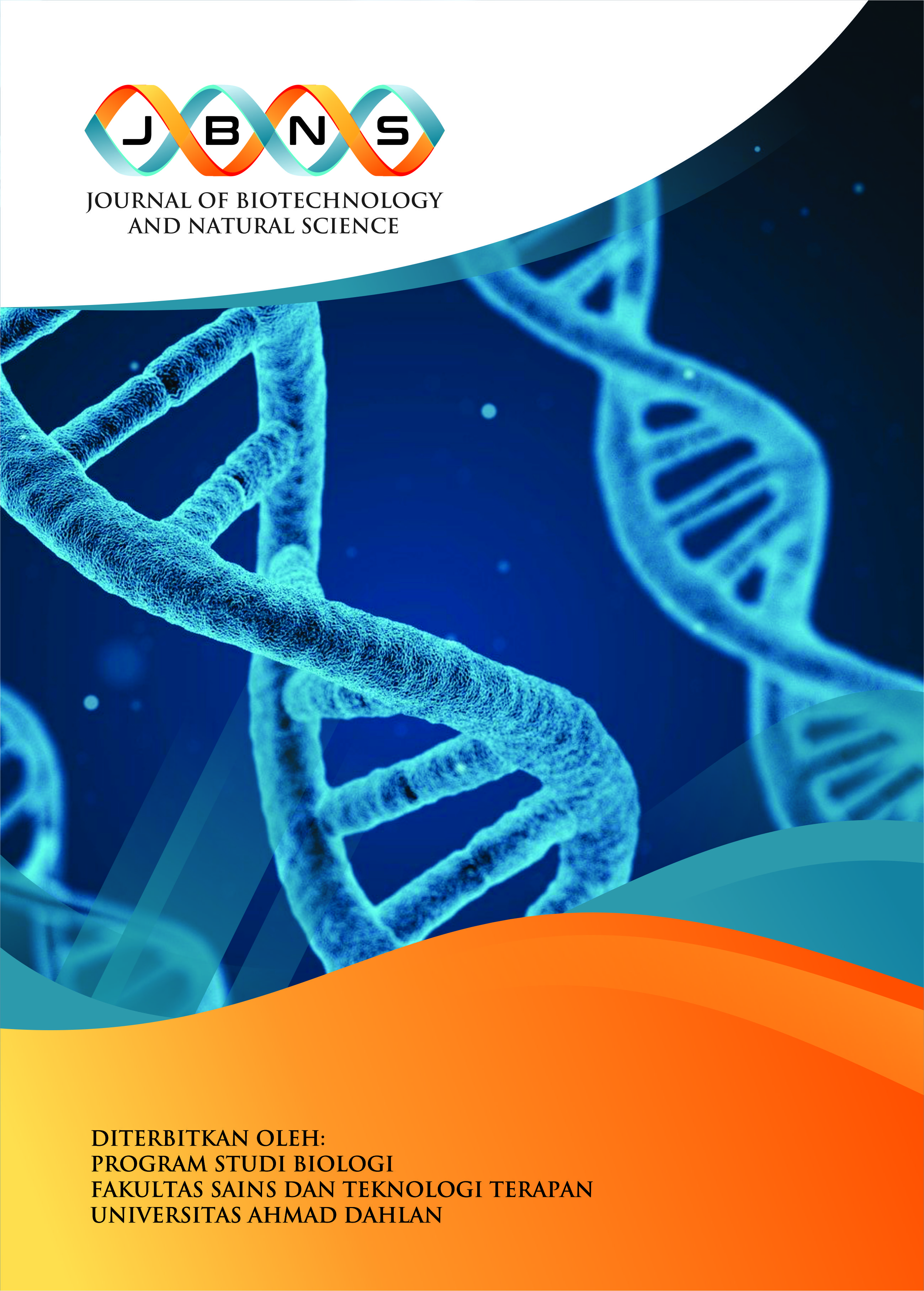Morphological Structure of the Body Setae as Mechanoreceptor on the Mesonotum of Telenomus remus Nixon (Hymenoptera, Platygastridae)
DOI:
https://doi.org/10.12928/jbns.v3i1.9424Keywords:
Hymenoptera, natural enemy, sensilla, mechanosensor, peripheral nervous systemAbstract
Telenomus remus is parasitoid on many Lepidpoteran. Morphological analysis on T. remus is important to understand their behavior and assest the quality of parasitoid comes from the mass rearing process. However, the information of T. remus body setae cuticle characteristics were limited. This study aimed to explore the body setae on the mesonotum of of T. remus by using electron microscopy analysis and characterize their cuticle characterisics to infer the putative function of the body setae. The results showed structures that support the body setae on the mesonotum as mechanoreceptor. The structure included the long and dangling seta peg, a socket, and a gap between a socket and the base of the seta peg. The putative function related to the biology and behavior of T. remus were discussed.
References
Aiello, B. R., Stanchak, K. E., Weber, A. I., Deora, T., Sponberg, S., & Brunton, B. W. (2021). Spatial Distribution of Campaniform Sensilla Mechanosensors on Wings: Form, Function, and Phylogeny. Curr Opin Insect Sci, 48, 8-17. doi:10.1016/j.cois.2021.06.002
Camhi, J. M. (1969a). Locust Wind Receptors: I. Transducer Mechanics and Sensory Response*†. Journal of Experimental Biology, 50(2), 335-348. doi:10.1242/jeb.50.2.335
Camhi, J. M. (1969b). Locust Wind Receptors: III. Contribution to Flight Initiation and Lift Control*. Journal of Experimental Biology, 50(2), 363-373. doi:10.1242/jeb.50.2.363
Cave, R. D., & Gaylor, M. J. (1987). Antennal Sensilla of Male and Female Telenomus reynoldsi Gordh and Coker (Hymenoptera : Scelionidae). International Journal of Insect Morphology and Embryology, 16(1), 27-39. doi:https://doi.org/10.1016/0020-7322(87)90054-7
Corfas, G., & Dudai, Y. (1990). Adaptation and Fatigue of a Mechanosensory Neuron in Wild-type Drosophila and in Memory Mutants. The Journal of Neuroscience, 10(2), 491-499. doi:10.1523/jneurosci.10-02-00491.1990
Dinges, G. F., Chockley, A. S., Bockemuhl, T., Ito, K., Blanke, A., & Buschges, A. (2021). Location and Arrangement of Campaniform Sensilla in Drosophila melanogaster. J Comp Neurol, 529(4), 905-925. doi:10.1002/cne.24987
EPPO, E. a. M. P. P. O. (2015). PM 7/124 (1) Spodoptera littoralis, Spodoptera litura, Spodoptera frugiperda, Spodoptera eridania. In M. Ward (Ed.), EPPO Bulletin (Vol. 45, pp. 410-444). doi:https://doi.org/10.1111/epp.12258
Fuller, S. B., Straw, A. D., Peek, M. Y., Murray, R. M., & Dickinson, M. H. (2014). Flying Drosophila Stabilize Their Vision-based Velocity Controller by Sensing Wind with Their Antennae. Proc Natl Acad Sci USA, 111(13), E1182-E1191. doi:https://doi.org/10.1073/pnas.1323529111
Gerling, D. (1972). The Developmental Biology of Telenomus remus Nixon (Hym., Scelionidae). Bulletin of Entomological Research, 61(3), 385-388. doi:10.1017/S0007485300047283
Gerling, D., & Schwartz, A. (1974). Host Selection by Telenomus remus, A Parasite of Spodoptera littoralis Eggs. Entomologia Experimentalis et Applicata, 17(3), 391-396. doi:https://doi.org/10.1111/j.1570-7458.1974.tb00357.x
Hengstenberg, R. (1988). Mechanosensory Control of Compensatory Head Roll During Flight in the Blowfly Calliphora erythrocephala Meig. J Comp Physiol A, 163(2), 151-165. doi:https://doi.org/10.1007/BF00612425
Hernández, D., Ferrer, F., & Linares, B. (1989). Introduccion de Telenomas remus Nixon (Hym.: Scelionidae) Para Controlar Spodoptera frugiperda (Lep.: Noctuidae) en Yaritagua Venezuela. 39, 45-61.
Iwasaki, M., Itoh, T., & Tominaga, Y. (1999). Mechano- and Phonoreceptors. In E. Eguchi & Y. Tominaga (Eds.), Atlas of arthropod sensory receptors: dynamic morphology in relation to runction (1 ed., pp. 177 - 190). Tokyo: Springer Japan.
Li, Z., Wang, W., & Zhang, L. (2021). Complete Mitochondrial Genome of Spodoptera littoralis (Lepidoptera: Noctuidae) from Egypt. Mitochondrial DNA Part B, 6(2), 432-434. doi:10.1080/23802359.2020.1870894
McIver, S. B. (1975). Structure of Cuticular Mechanoreceptors of Arthropods. Annu Rev Entomol, 20(1), 381-397. doi:10.1146/annurev.en.20.010175.002121
Müller, M., & Wehner, R. (2007). Wind and Sky as Compass Cues in Desert Ant Navigation. Naturwissenschaften, 94(7), 589-594. doi:https://doi.org/10.1007/s00114-007-0232-4
Nordlund, D. A., Lewis, W. J., & Gueldner, R. C. (1983). Kairomones and Their Use for Management of Entomophagous Insects. Journal of chemical ecology, 9(6), 695-701. doi:10.1007/BF00988776
Pomari-Fernandes, A., de Freitas Bueno, A., & De Bortoli, S. A. (2016). Size and Flight Ability of Telenomus remus Parasitoids Reared on Eggs of the Factitious Host Corcyra cephalonica. Revista Brasileira de Entomologia, 60(2), 177-181. doi:https://doi.org/10.1016/j.rbe.2016.02.004
Schwartz, A., & Gerling, D. (1974). Adult Biology of Telenomus remus [Hymenoptera: Scelionidae] Under Laboratory Conditions. Entomophaga, 19(4), 483-492. doi:10.1007/BF02372784
Thurm, U. (1965). An Insect Mechanoreceptor. I. Fine Structure and Adequate Stimulus. Cold Spring Harb Symp Quant Biol, 30, 75-82. doi:https://doi.org/10.1101/sqb.1965.030.01.011
Van Waddill, H., & Whitcomb, W. H. (1982). Release of Telenomus remus [Hym. Scelionidae] Against Spodoptera frugiperda [Lep.: Noctuidae] in Florida, U.S.A. Entomophaga, 27(2), 159-162. doi:10.1007/BF02375224
Wikantyoso, B., Imai, T., Himmi, S. K., Yusuf, S., Hata, T., & Yoshimura, T. (2022). Ultrastructure and Distribution of Sensory Receptors on the Nonolfactory Organs of the Soldier Caste in Subterranean Termite (Coptotermes spp.). Arthropod Struct Dev, 70, 101201. doi:https://doi.org/10.1016/j.asd.2022.101201
Wikantyoso, B., Ohmura, W., Imai, T., Fujii, Y., Himmi, S. K., & Yusuf, S. (2023). Sensitivity and Orientation to Sustained Airflow by Coptotermes formosanus Soldier Termites (Isoptera, Rhinotermitidae). Journal of Insect Behavior. doi:10.1007/s10905-023-09834-7
Wolf, H., & Wehner, R. d. (2005). Desert Ants Compensate for Navigation Uncertainty. J Exp Biol, 208(22), 4223-4230. doi:https://doi.org/10.1242/jeb.01905
Yanagawa, A., Shimizu, S., Noma, K., Nishikawa, M., Kazumasa, O., & Yokohari, F. (2009). Classification and Distribution of Antennal Sensilla of the Termite Coptotermes formosanus (Isoptera: Rhinotermitidae). Sociobiology, 54, 327-349.
Zhang, S., Zhang, Z., Kong, X., Wang, H., Luo, J., & Yang, Z. (2015). Sensilla on Different Organs of Female and Male Telenomus dendrolimusi Chu (Hymenoptera: Scelionidae). Microsc Res Tech, 78(11), 1010-1018. doi:https://doi.org/10.1002/jemt.22566
Zhang, Y.-R., Ren, L., Zhang, L., & Luo, Y. (2015). Ultrastructure of Antennal and Posterior Abdominal Sensilla in Chlorophorus caragana Females. Micron, 75, 45-57. doi:https://doi.org/10.1016/j.micron.2015.04.014
Zhang, Z., Li, X., Chen, L., Wang, L., & Lei, C. (2016). Morphology, Distribution and Abundance of Antennal Sensilla of The Oyster Mushroom Fly, Coboldia fuscipes (Meigen) (Diptera: Scatopsidae). Revista Brasileira de Entomologia, 60, 8-14. Retrieved from http://www.scielo.br/scielo.php?script=sci_arttext&pid=S0085-56262016000100008&nrm=iso
Downloads
Published
Issue
Section
License
Copyright (c) 2023 Bramantyo Wikantyoso, Putra Ichsan

This work is licensed under a Creative Commons Attribution-ShareAlike 4.0 International License.

